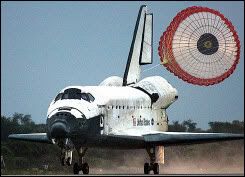Space shuttle Discovery completes successful ISS mission

Space shuttle Discovery and its seven-member crew has landed in Florida after a 13-day mission that advanced construction of the International Space Station.
Discovery touched down at 2232 GMT on the landing strip at the Kennedy Space Center, near Cape Canaveral, where it had lifted off in a nighttime launch on December 9.
"You have seven thrilled people here," shuttle commander Mark Polansky said just after landing.
A controller at the Mission Control Center in Houston, Texas, replied: "Congratulations on what was probably the most complex assembly mission of the Station to date."
The Discovery astronauts spent eight days at the International Space Station (ISS), continuing the construction of the orbiting laboratory by attaching a two-tonne truss to its girder-like structure in the first of four space walks.
During the next two space walks, they rewired the station's power system and put it on a permanent basis.
A fourth space walk was added Monday to shake loose a solar array panel that had gotten stuck as it was being folded.
"It was a wonderful end to a great mission," Michael Griffin, a NASA administrator, said at a news conference at Kennedy Space Center where he welcomed the astronauts after they left the spacecraft.
"The crew on orbit and the crew on the ground could not have done better," he said.
The shuttle's return to Earth initially was scheduled Thursday but the mission was extended a day to allow for the unplanned space walk.
Poor weather conditions in Florida had scotched an earlier scheduled landing Friday and National Aeronautics and Space Administration officials had considered bringing the shuttle down at alternative sites.
A decision to land at Kennedy was made only at the last minute and "it turned out to be a great one," Griffin said.
NASA officials had hoped weather conditions would improve enough in Florida to avoid having to land the space shuttle at Edwards Air Force Base in California or White Sands Space Harbor in New Mexico.
A landing at either location in the western United States would have meant NASA would have to fly the shuttle to Florida, in the southeast, on the back of a modified Boeing 747 plane, which would cost some 1.7 million dollars.
The shuttle plunged at more than 26,500 kilometers (16,500 miles) an hour as it descended through the Earth's atmosphere, triggering a double sonic boom as it lowered through the skies above the runway on Florida's Atlantic coast.
On board were six US astronauts and one from the European Space Agency (ESA), Christer Fuglesang, Sweden's first astronaut.
After this mission, NASA plans at least 13 more shuttle flights -- including five in 2007 -- to complete construction of the International Space Station by 2010, when the three-spacecraft shuttle fleet is due to be retired.
ISS construction fell years behind schedule after the 2003 Columbia tragedy when the spacecraft disintegrated minutes ahead of landing, killing all seven astronauts aboard.
NASA suspended the shuttle program to deal with safety problems. The space shuttle Atlantis mission in September marked the resumption of ISS construction.
Discovery carried astronaut Sunita Williams to the ISS, where she will remain for six months. Williams replaced Thomas Reiter, a German ESA astronaut who had been on the station since July and who returned on Discovery.

No comments:
Post a Comment